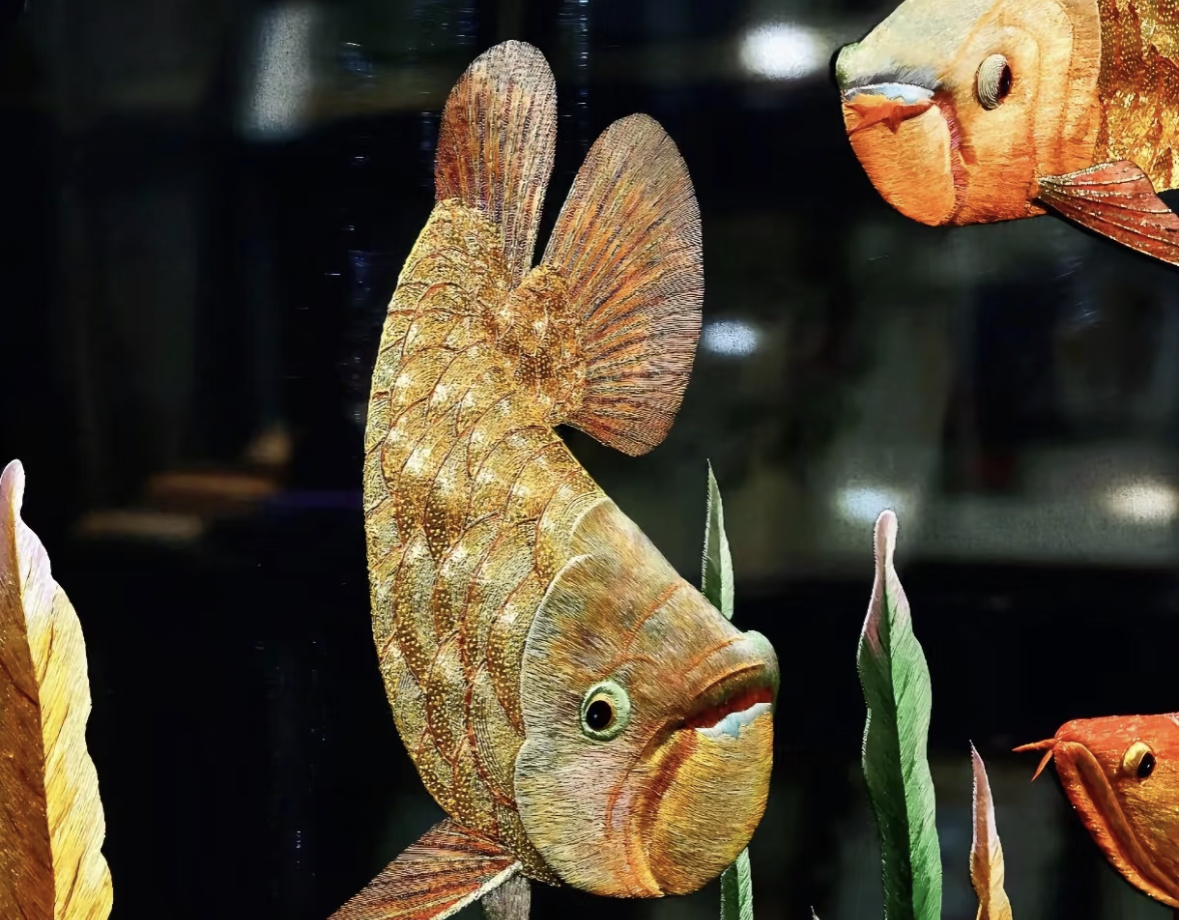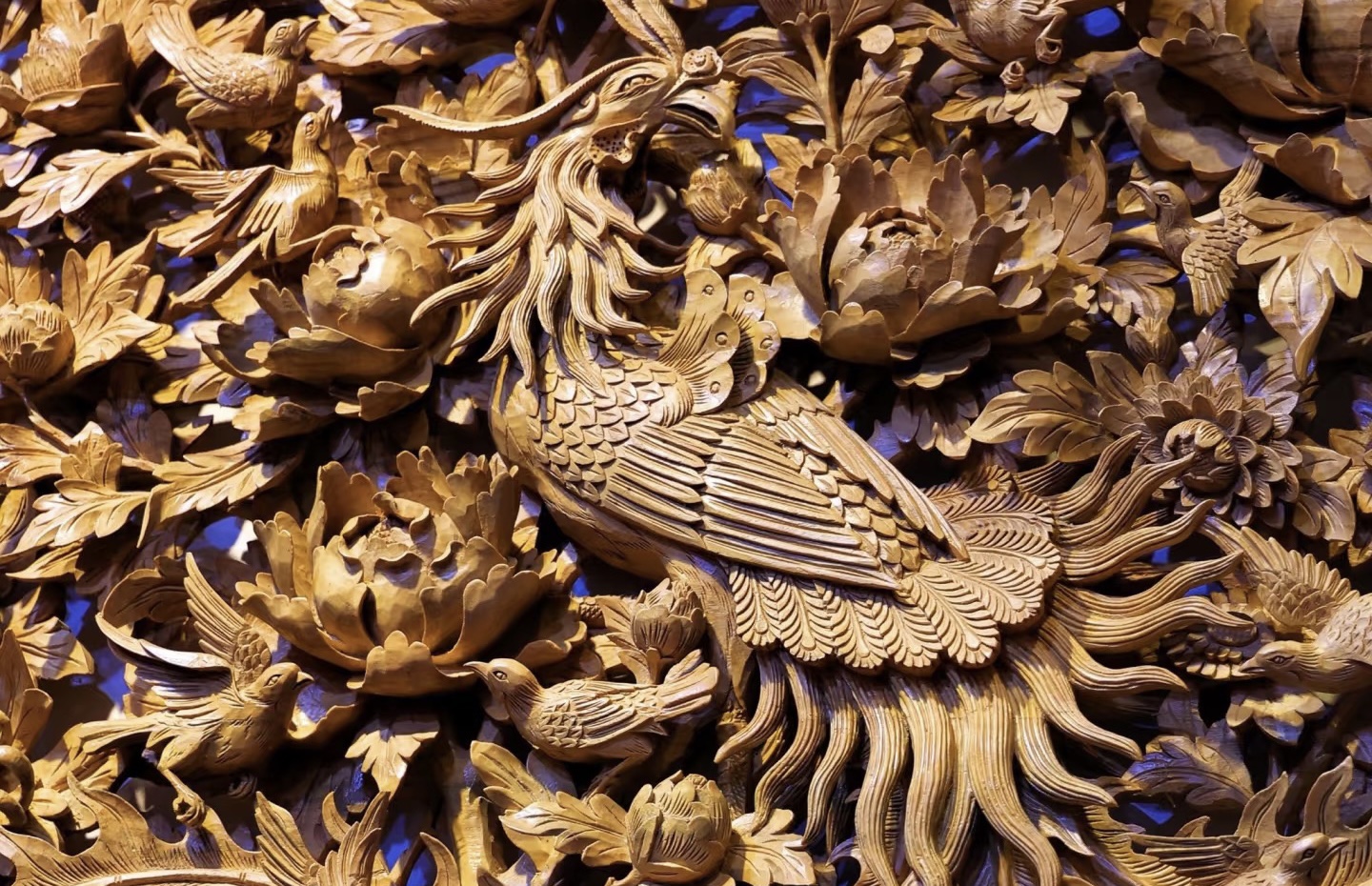Lingnan Non-Heritage Treasures: Teochew Wood Carving, Duan Inkstone Making and Canton Embroidery
I. Teochew Woodcarving: Chiseling and Lacquering
Core Techniques:
Teochew woodcarving is unique in the world for its “multi-layer openwork” technique, which requires craftsmen to carve 5 to 8 layers of decorations on a 1-cm-thick piece of wood, with birds, animals, feathers, and pavilions and window lattices appearing in every detail, with the thinnest part being only 0.2 millimeters. The gold lacquer process is particularly delicate, requiring 12 coats of raw lacquer, each of which takes 24 hours to dry under the shade, resulting in a visual effect of “richness and splendor”.
History:
The art was born from the tradition of architectural decoration in Chaoshan, which is characterized by “seven parts of carving and three parts of material”. The beams and pillars of ancestral halls, shrines and tables, and furniture screens are all carvings of wood, and the themes are mostly based on myths and legends, as well as urban life, such as “Guo Ziyi's birthday worship” and “fishermen, woodcutters, farmers, and scholars”, which are both practical and ritualistic.
Representative works:
Wood carving of the Heavenly King Hall of the Kaiyuan Temple in Chaozhou: a work of the Qing Dynasty, the 4-meter-high statue of the Four Heavenly Kings has flowing folds of clothes, and the scales of the armor can be shivered gently with the wind.
The modern work “Two Phoenixes Facing Peony”: a 1.2-meter diameter circular hanging screen with 12 layers of openwork carvings, where the tail feathers of the phoenix and the stamens of the peony flow with the changing viewpoints.
Where to visit:
Chaozhou Woodcarving Art Museum (Pai Fang Street, Chaozhou City): the museum has a collection of more than 300 pieces of woodcarving from the Ming and Qing dynasties to the contemporary era, including the treasure of the museum, the Golden Lacquered Woodcarving Grand Shrine.
Chen Peichen Woodcarving Studio (Chaoan District): watch the craftsmen chiseling, polishing and lacquering on site, and customize small wood carvings (e.g. tea bags, bookmarks).
Featured activities:
Every year in the first month of the lunar calendar, experience the traditional techniques of lacquer preparation and gold leaf application, as well as hand-painting wood carvings with gold.
II. Duan ink stone production: stone quality heavenly workmanship, warm and moist for thousands of years
core skills:
Duan ink stone is limited to the Zhaoqing Duanxi basin of the three famous pits LaoKeng, MaZiKeng, SongKeng, stone products to “freeze”, ‘eye’, “fire press” as the most expensive. The quarrying of stone is done by hand in a 100-meter-deep mine, the carving is done according to the principle of “composition of stone and art according to material”, and the polishing is done according to the identification standard of “warm and moist as jade, and the sound of knocking on the wood” -- the quality Duan inkstone can be studied by the ink, and the sound of knocking on the inkstone is as thick as a wooden box.
History:
Duanxi inkstones began in the early Tang Dynasty and flourished in the Song Dynasty, and became a must-have for the literati because “the ink is not damaged”. Su Shi once praised “Duanxi stone pool thick for ink, candlelight shooting each other flying across”, Mi Fu “ink stone history” detailed records of Duan ink stone quarrying process. During the Qing Dynasty, most of the imperial inkstones were engraved with “Qianlong Nianzhi” mark, and are now in the National Palace Museum.
Representative works:
“Lanting inkstone”: old pit stone carving, the inkstone surface cleverly left natural stone eyes for ‘goblet’ characters, ink pool hidden “Lanting Preface” micro-engraving.
Duanxi Dragon Emperor Inkstone: weighing 2 tons, the inkstone is carved with 108 dragons of different shapes and sizes, and is now displayed in the Duanxi Inkstone Museum in Zhaoqing.
Visiting place:
Zhaoqing Duanyan Museum: Systematically displaying quarrying tools, carving knives, famous inkstones through the ages, and touching the original “fossilized inkstone”.
Duanxi Old Pit Ruins (Yanzhou Island): Take a boat ride to the island to explore the thousand-year-old mining cave and observe the natural layering of “stone flesh” and "stone skin.
Featured activity:
Experience the whole process of “drawing - chiseling - polishing” at the Inkstone Village Workshop in Huanggang Town, and make an inkstone of “Su Chi” by your own hands.
III. Canton Embroidery: Horse Tail Velvet Wrapping, Needle and Foot Fragrance
Core Skills:
Canton Embroidery is unique in the technique of “Horse Tail Velvet Wrapping” -- taking white horse tail as the core, wrapped with colorful velvet threads, embroidered with dragon scales and peacock plumes that are hard and three-dimensional, and can be stood up in 3D. Modern innovations are even more amazing: in 2016, the work “Morning Sun” was carried on board the Shenzhou XI spacecraft, completing the experiment of “free embroidery without taut frame” in a microgravity environment in space, creating a “spaceflight legend on the tip of a needle”.
History:
Guangyao was recorded in the Tang Dynasty, and became a tribute product in the Ming and Qing Dynasties. It was renowned overseas for its rich colors and varied stitching techniques, and was exported to Southeast Asia and Europe. Most of the traditional themes are Lingnan scenery, such as lychee, red cotton, Cantonese opera characters, and the use of “white water” to emphasize the layers, and a picture of “Hundred Birds Towards the Phoenix” requires a million times of threading the needle.
Representative works:
Morning Sun: experimental work of space embroidery, using silver thread to embroider the skyline of Zhujiang New City, and adopting “robbing scale overlay embroidery” at the halo of the morning sun, realizing the precision control of 0.1 mm in a weightless environment.
The Peacock Opening Screen of the Qing Dynasty: Horsetail embroidery with feathered branches and gold foil on the eye spots, which will not fade for a hundred years, is now in the collection of the Thirteen Houses Museum in Guangzhou.
Where to visit:
Guangzhou Museum of Canton Embroidery (inside the Guangzhou Academy of Fine Arts): exhibits of Ming and Qing Dynasty Canton embroidery costumes, opera costumes, and export paintings, with physical comparisons of stitches such as “waterway” and “seeding” visible.
Cotton Tree Embroidery Workshop (Liwan District): watch Chen Shaofen, a national heirloom demonstrating ponytail wrapping, and experience embroidering a fan (basic).


